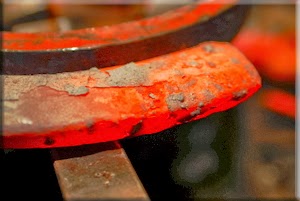Figuring out how to control the inevitable surface oxidation of steel which results from forging can take some time and work. Finding a source of information about the subject can also take some work.
When I started my search I used the term firescale - one word. That led mostly into the world of copper and silver work.
When I started with fire scale as two words, I got the same choices. When I searched for Blacksmith I found the two word explanation under the origin of the term blacksmith in relation to the black iron oxide scale.
Iron oxide isn’t always black. I encounter shades of red fairly often. When I tried to learn more about the chemistry I found there are 16 known oxides and oxyhydroxides of iron. That’s way more than I need to know. In general, Fe2O3, hematite, is red and is the main mineral source for the iron industry. Fe3O2, magnetite, is black. Mill scale is black but oxidizes toward red which is more stable. The blacksmith’s black magnetic scale is a combination of FeO and Fe2O3 (Fe3O4). There is a lot more information readily available about oxides of iron and to the makers of pigments it is a big deal, but I’m not so much interested in colors as I am in the oxidized surface texture and it’s visibility.
When working bar stock I don’t have a lot of trouble getting the appearance I want. Partly, that is because only a small area of surface is usually visible. The problem seems more difficult when working sheet. Both are HR A36 but the surface texture is more obvious when a larger area can be viewed. I try to get all the sheet pieces I need out of the same piece of stock. I once had a project which used sheet acquired at different times and I never got the surfaces of the various pieces to look the same.
The cycles of scale formation and scale removal and forging leaves a record which is akin to weathering in a landscape and individual artists develop opinions about what they like. With practice, how they manage their fire and how they use their tools yields the result they want.
I have become very familiar with how my finishes work on pieces which I have coal-fire forged and tumbled. Once I have something figured out the way I like it, I am usually reluctant to make any changes unless it is in the spirit of experimentation. Yet, when I think back to when I used a gas forge a lot I recall noticing differences in how scale formed in the coal and the gas forges. I tried to look up information about it on the web but got nowhere because the results were swamped with how coal fired power plants compared to gas powered plants.
I think it would be interesting to set aside some time and do some well thought out experimenting with fire scaling. It could be handy to master a variety of reproducible textures. I’ll put that on my “goals for 2014” list.
 |
| Hot steel scale. |
 |
| Blacksmith's black magnetic scale. |
 |
| Fire scaling an element. |
 |
| Prominent fire scale texture. |

No comments:
Post a Comment